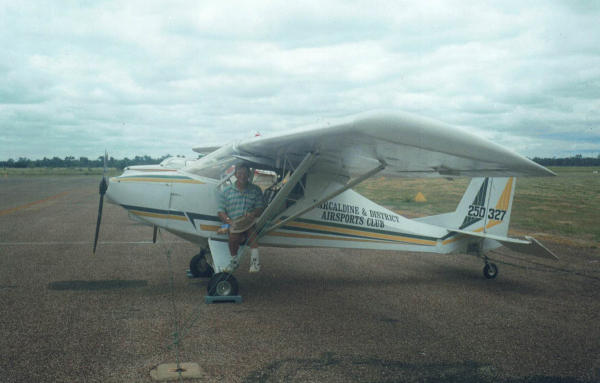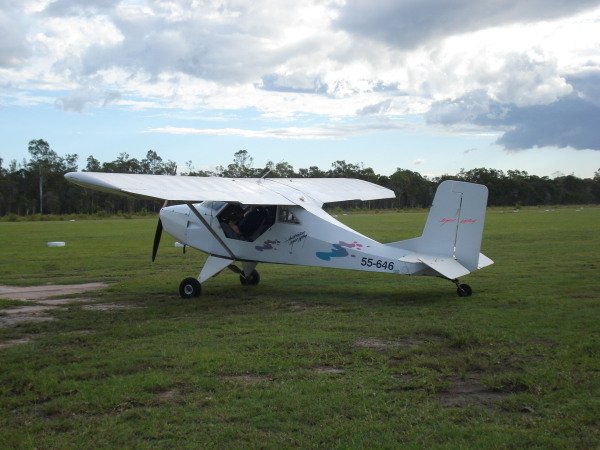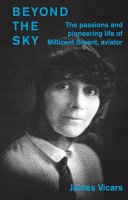-
Posts
1,683 -
Joined
-
Last visited
-
Days Won
14
Content Type
Profiles
Forums
Gallery
Downloads
Blogs
Events
Store
Aircraft
Resources
Tutorials
Articles
Classifieds
Movies
Books
Community Map
Quizzes
Videos Directory
Everything posted by FlyingVizsla
-
Our Lightwing 55-0646. Mr FV's son has advertised it on Facebook Marketplace (I assume) and has some interest. So you may see it in more than one place. We are not on Facebook, so can't look at what he has said, but I think its a higher price. We don't have time to fly all our planes & maintain them, and our hangars, everything is getting old!! including us! Hope it goes to a "good home".
-
@Arron25 Here is the old girl! That's Lennie Fitzgerald, who learned to fly at 69(?), our oldest student. Unfortunately Lennie is long gone. The plane started with Gympie Aero Club (you could still see the lettering from inside on a sunny day) where Mr FV flew it. Barcaldine Aero Club bought it and trained a number of students. I did my conversion on it. Then it was a rash decision (to my mind) to do a fire sale, with the loan nearly paid and a new engine in it. It ended up with Keith Page, but a few years ago he bought a Jab and I have not heard of it since. The Barcaldine Club folded just after selling the plane. Old photo albums can be so depressing, all those lovely people & planes gone. Hope to pass some of ours on to people who will enjoy them.
-
Well, want it to go to a good home, someone who is interested in flying it, rather than someone who just wants to sell it on (we had two looking to buy everything for nothing & Mr FV got the irrits and ended negotiations). So Last I Heard ... $10k with old engine, $20k with present 912. Others have asked for engineless price, or price for 912s only - no idea. It isn't for a novice as it isn't the best that Lightwing produced. Needs some future fabric work on the wings, elevators recently done, flying condition, but hasn't been taken up this year. Hobbs 1624. One buyer asked RAAus about using an "On-Condition" 912 with this plane, and there is a fee and inspection required. I flew a similar Lightwing GA with the Barcaldine Aero Club (and Mr FV flew the same aircraft at Gympie Aero Club - small world!) and it was an issue for novice pilots. So many in the Barcy Club nosed over or ground looped, that the Club kept a spare prop and ordered a new one. I was one of the very few that didn't do either. Land slow, taxi slow.
-
I've been lurking on the Forum nearly every day, but haven't posted much. Still have the C152, RANS and Karasport, but doing a bit of hangar clear-out to sell one of our 3 hangars. Flying Club keeps me busy (Secretary/Treasurer) & Mr FZ on the committee. This life of retirement seems far too busy and hectic. How about you? Want a cheap Lightwing? It was bought so his boys could learn to fly, but they never did. Sue
-
Selling on behalf of the son. Sonerai kit (no engine, no avionics etc) purchased 2008 with the intention of building, from a group who had built 3 (this is the 4th). Still in crates & boxes, never opened, didn't start. In our hangar at Childers Qld. Any offers. Photos - fuse frame, wings in crate. There is another plastic box of parts and instructions.
-
Having a hangar clean out. Lightwing GA, 450kg, 2 seat, hangared at Childers Qld. Has a new 912 with approx 80 hours, also available 912 (on condition) which it replaced. L2 maintained until recently, suitable for training. We've owned it since 2003. Rego paid till Feb 2024.
-
66yo man charged with manslaughter over plane crash on Ball Bay beach 66yo man charged with manslaughter over plane crash on Ball Bay beach - ABC News A 66-year-old man has been charged more than a year after his light plane crashed on a North Queensland beach and killed his 83-year-old passenger. The crash occurred on Christmas Eve 2021, shortly after the plane took off for a private leisure flight around nearby islands from the Ball Bay airstrip. The two-seater plane made an emergency landing and crashed on Ball Bay beach. Ball Bay is a tiny coastal town located 35 kilometres north of Mackay. The passenger, from Kuttabul, died at the scene, while the pilot, a man from Halliday was discharged from hospital later that day. The pilot is due to face court today in Mackay charged with one count of manslaughter, as well as flying an aircraft without a licence, and failing to carry out maintenance and satisfy safety requirements. Yesterday, Mackay Detectives and the Civil Aviation Authority executed a search warrant at a Halliday Bay residence and finalised their 14-month investigation. More to come.
-

Plane Crash Mount Buffalo 4 Jan 2023
FlyingVizsla replied to FlyingVizsla's topic in Aircraft Incidents and Accidents
An update: Emergency services have rescued a man who was trapped following a plane crash in the Buckland Valley, in Victoria's north-east. Police said the plane took off from Porepunkah airstrip about 4:40am before crashing into trees. Emergency services were not called until just after 11am when the Canberra rescue coordination centre noticed a plane had not checked in and raised the alarm. -

Plane Crash Mount Buffalo 4 Jan 2023
FlyingVizsla posted a topic in Aircraft Incidents and Accidents
Pilot rescued after being trapped in plane crash in Mount Buffalo area Pilot rescued after being trapped in plane crash in Mount Buffalo area - ABC News Emergency services have rescued a man who was trapped following a plane crash in the Mount Buffalo area in Victoria's north-east. Police said it was understood that the plane took off from Porepunkah about 4.40am before crashing into trees. They said the male pilot, believed to be the sole occupant, was being treated at the scene. Ambulance Victoria said its crews were called to reports of the accident just after 11am, with paramedics on the scene assessing the man. "A man believed to be in his 50s is stable with upper and lower body injuries and will be airlifted to hospital," a spokesperson said. -

NSW motor vehicle licence at 75year old
FlyingVizsla replied to Geoff_H's topic in Student Pilot & Further Learning
We do the 75yr + Qld licence. We combine the annual eye examination with this one - I think Medicare only pay for one consultation a year. At the same time do the Commercial truck standard (if you want to) which involves peripheral vision test - as the optometrist said, its proof you are not a blind tunnel vision oldie causing accidents. The Doc is happy because he doesn't have to get his receptionist to line you up in the passageway and set up the chart and walk back and forth getting you to read with each eye while the patients line up at the desk. Optometrist is no charge, but if new glasses are needed then we pay for them. Doc adds $30 for receptionist to do eye test, but bulk bills licence, unless it is Commercial Truck ($100 for tests + $110 appointment) and you MUST see an optometrist first. Think of it as a birthday present - Optometrist, glasses, doctor, Dept of Transport. In Qld our licences renew on your birthday. -
In the 1990's there was a product available - a thin band of foam that slid over the arm of the glasses that had tapered sides to form a seal between headset foam seal and skin/glasses. The headset gel seals are much better at conforming, so I have not needed them for years. The product was very simple, but expensive for what it was, simply because of the small market.
- 7 replies
-
- glasses
- sunglasses
-
(and 1 more)
Tagged with:
-
Bogged airplane recovery at Rockhampton airport continues five days after sinking in soft ground - ABC News A Qantas spokesperson said flight QF1798, travelling into Rockhampton from Brisbane, landed normally on Monday night. But while taxiing at low speed to the parking bay the pilot "inadvertently guided the aircraft across soft ground and became stuck just before the terminal", the spokesperson said.
-
In Australia in the mid 1920s, flight was still new, dangerous and glamorous - and aviators were all men. That was until a petite and quietly-spoken 49 year-old mother of three, Millicent Bryant, took her first flight, igniting a passion that led her to become the first woman in the Commonwealth outside Britain to gain a pilot's licence. While newspapers all over Australia began following her progress in the 'race', few outside her family knew the determination and depth of personality that took her into other areas considered unusual for a woman at that time, such as business and politics. And were it not for an ironic stroke of fate, her name may have become as familiar as other pioneers of the air such as Smithy, Hinkler or Nancy Bird Walton. Working from Millicent's own rediscovered letters and writings as well as newspapers and other historical sources, this innovative biographical work reveals a pioneer of the sky and beyond. On one hand it tells, for the first time, of a flyer who was also a businesswoman, small-scale property developer, golfer, student of Japanese at Sydney University and early motorist who had driven over 35,000 miles around New South Wales up to the summit of Mt Kosciuszko - and who could fix her own car to boot. On the other, it seeks to illuminate the inner story of a highly individual, modern woman whose life encompassed not only hidden romance, heartbreak and tragedy but also a spirit of change in the social, political and marital conventions of 20th century Australia. Mentions Edgar Percival who was a friend of the family. A good read in two parts - first her flying, then Part 2, going back a couple of generations, the family history. I was left wondering - had she not drowned in a ferry accident, she would be in our history books and newspapers for a myriad of other reasons. Such potential cut short.
-

Rainbow Coast Flying School - Albany, WA - Now Closed.
FlyingVizsla replied to poteroo's topic in AUS/NZ General Discussion
Ralph, When the book comes out, I would like to buy one. Sue -
From the ABC Patients being assessed after light plane crash at Ball Bay, north of Mackay - ABC News Emergency services are at the scene of a light plane crash on a beach in North Queensland. The Queensland Ambulance Service says the incident happened at about eight o'clock this morning at Ball Bay, north of Mackay. Two patients were being assessed but information about their conditions is not yet available.
-
I hope I wasn't too much of an influence! There were 1,226 voters who cast 2,138 votes (you could vote for two candidates), which means 314 members voted for only one candidate. Rod Birrell failed by only 15 votes (about 1.2%) While I can't get into the mind of the voting members, it sometimes happens that the mediocre one gets up, simply because the other candidates elicit strong feelings eg "Wouldn't vote for him in a fit", and "He's my top pick" then people have to choose the other candidate(s) ... someone who doesn't rock the boat and isn't notorious one way or the other. I have seen it time and again in Council elections where a guy who contributes nothing, says nothing in Council, somehow gets the most votes. Not saying this is the case, but maybe The Devil You Don't Know may be at play, or Simon has garnered a larger support base this year. Hopefully he will contribute. The whole Board will be retiring over the next few years as the Constitution limits their Terms. We need new people in earlier rather than later, for continuity. It is a job, that done properly, will consume much of your time and energy.
-
Election results are out - Simon and Luke got up. Rod Birrell fell short by a few votes to Luke. Simon got the clear majority. More voted in the new on-line system than the old Reply-Paid mail in. There were no Informal votes - probably because you had to provide a valid membership and you were unable to vote after the closing date. Look forward to seeing what Simon can contribute. This is Luke's last term.
-
All candidates are required to disclose any financial interest in aviation on their election statement. I would expect candidates to have some "skin in the game" and as RAA members they should have some aviation experience. I would be suspicious of someone who does not fly wanting to be a Director, also someone who is, say, the Largest Importer of Ultralights might try to use his influence. But at the end of the day they are one voice in 7. The Board need to know a lot about running a business. setting policy and negotiating with Govts.
-
I did comment on a previous election, on the independent report on the Board, which showed 3 Directors were uncooperative or under performing. I had hoped that they may have changed their attitudes. Rod was one. Back in the days when there were 13, several were passengers, only there for their own benefit. I have been copying and digitising the early AUF magazines and it is appalling that meeting reports mentioned Board members who arrived with their meeting material, sent a month ahead to allow consultation with their State members, was still unopened when they arrived in Canberra and hours were wasted while they read it. Most were CFIs of their own schools and were looking after their own interests. RAAus Board Election 2019 - Page 3 - Governing Bodies - Recreational Flying Part of the report said ... .. struggle to engage several members as they do not respond to emails, return phone calls and so forth. Alan Middleton often criticises the engagement of board members but fails to return calls and takes an aggressive tone in email (on one occasion I called him 4 times in relation to some out of session matters with no reply). Rod Birrell and Eugene Reid are similar. I wasn't greatly impressed with Simon. He has had a year to get immersed in RAA, but seemed to not have much of a grasp of the issues. Luke is good value.
-
RAA Board Election is open for voting. A change from previous years - the Election Statements are on line (not in the magazine) and you will be voting on line too. I watched the "meet the candidates" live stream, where only two participated. Luke Bayly (a current Board Member) and Simon Ozanne (who unsuccessfully stood last time). Rod Birrell "did not respond" whatever that meant. There are two seats up for grabs. You can watch it on YouTube or Facebook. Members should have received an email from Verovoting. Those without an email will get something in the mail. The election opened 1st Sept and closes 28th Sept. The Constitution limits terms to 3, so there will be a number of current Board Members who will not be able to stand again. If elected, it will be Luke's last term. Same with Eugene and other long term Board members. Consider carefully, and vote.
-
So sorry to hear this Doug. I have followed your posts for years with wonder and interest. All the best for the future. 🙂 Sue
-
untilIsis Flying Club was formed in September 1991. To celebrate 30 years there will be a fly-in 18-19th Sat/Sun Sept 2021. Welcome to fly in Sat afternoon. Sunday Breakfast. For more information [email protected] *subject to COVID restrictions, if any.
-
untilIsis Flying Club Inc was formed 9th Sept 1991 at the Childers Airstrip. It has grown to be a vibrant club with about 20 hangars and 35 members. To celebrate this milestone the Club will host a lunch at the Isis Club 46 Churchill St Childers Qld for members, guests and friends. $10 each for members and partners, $20 each for non members. RSVP to the Secretary [email protected] before 1st Sept 2021. *subject to COVID restrictions if any.











